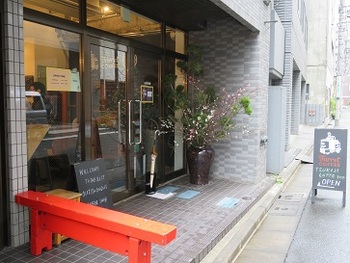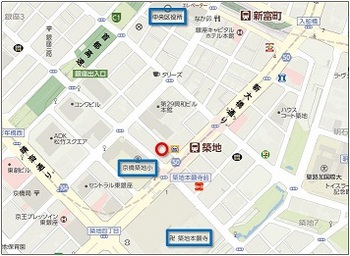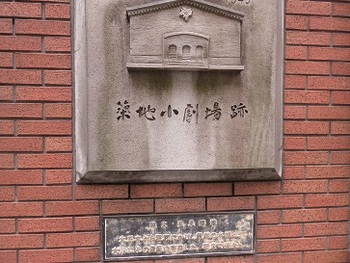After February every year, you can hear a letter saying, "Kawazu cherry blossoms at the foot of Chuo-ohashi Bridge on the Sumida River have bloomed."
The Sumida River also makes you feel that spring is coming soon.
 (Kawazu Sakura on February 14)
(Kawazu Sakura on February 14)
"Chuo-ohashi Bridge" over the Sumida River. This bridge, which opened in 1993, connects the Tsukishima and Tsukuda districts to the Yaesu Exit of Tokyo Station by a single road.
This time, I would like to talk about this "Chuo-ohashi Bridge" that I feel.
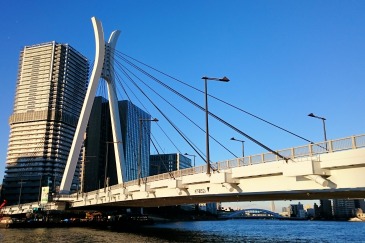
The white and high main tower is very distinctive, but the cable comes out from the top of the main tower, so when you come near this bridge, your gaze naturally turns toward the sky.
The "height" main tower in harmony with this cityscape, which has many high-rise apartments nearby, shows a presence without being buried in the cityscape, and the "diagonal" line created by cables gives a slightly different accent to the cityscape at right angles.
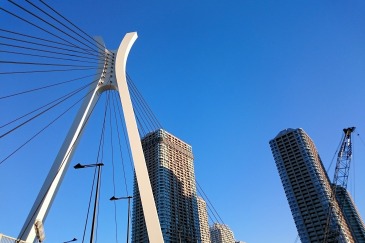
It is this white main tower, but it imitates the shape of a helmet. In the past, the Tsukuda area was an island such as Tsukuda Island and Ishikawajima in the Edo period, but Ishikawajima was once called Yoroijima, and it was called "Kabuto" with a pair of "armor". It is said that it was designed.
It's a helmet.
Depending on your point of view, it looks like a giant who played banzai.
Depending on where you look up, it looks like a "gigantic spider".
 Well, what does each person look like? You may be better at this kind of thing.
Well, what does each person look like? You may be better at this kind of thing.
This bridge has a wide sidewalk and can be planted, so you can walk comfortably, but one of the major features is that the bridge girder is large and "curve".
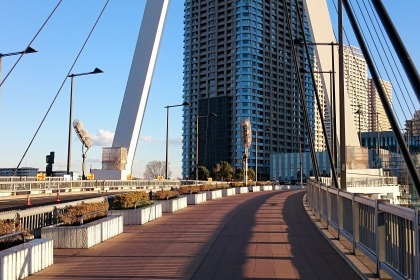
The type of bridge is "Shachokyo". The Shaping Bridge hangs the bridge girder by connecting several cables coming out of the main tower directly to the bridge girder.
It seems that the number has been increasing recently because it can be designed with a high degree of freedom according to the scenery of the place, such as the number of main towers and the position where the cable is to be placed.
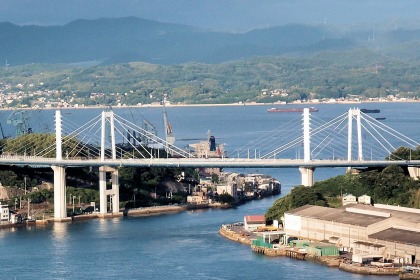 (Example of Shahari Bridge: Onomichi-ohashi Bridge (back) and Shin-Onomichi-ohashi Bridge (front) in Onomichi)
(Example of Shahari Bridge: Onomichi-ohashi Bridge (back) and Shin-Onomichi-ohashi Bridge (front) in Onomichi)
In the case of Chuo-ohashi Bridge, the curved bridge girder is hung, so I think that it was probably designed with complicated calculations, but recently such a complicated bridge with such a complicated shape can be realized with a diagonal bridge.
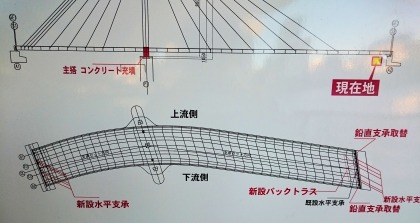 (plan view of the bridge girder)
(plan view of the bridge girder)
Also, the bridge girder is not only a curve but also a bow upward, so if you try to cross this bridge, you will not be able to see the destination you cross.
If you think, "What is the other side of the bridge ahead?", Your feet will head toward the top of the bow and the middle of the bridge girder at the top of the curve.
In the middle of the bridge girder, the best visibility is "outside of the curve" regardless of whether you look at the direction of travel. If you look at the direction of the river here, you will see the "Messenger Statue" by Ossenzackin. The Sumida River and the Seine of France are friendly rivers, donated by Paris, and this statue is displayed in the upper reaches of the Sumida River, toward the Eitai Bridge and the Sky Tree.
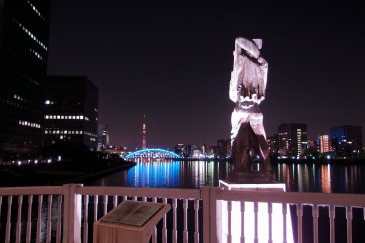 It is a statue holding a sailing ship, the emblem of Paris, on his right arm, but from the top of the bridge, the front side of the statue is not clearly visible, and it is mysterious place of this statue that I do not know what is going on.
It is a statue holding a sailing ship, the emblem of Paris, on his right arm, but from the top of the bridge, the front side of the statue is not clearly visible, and it is mysterious place of this statue that I do not know what is going on.
On the north side of Ishikawajima Park next to this bridge is the Paris Square, which shows the friendly relationship between Tokyo and Paris, and the design of the Chuo-ohashi Bridge is also a French design company, so the vicinity of this bridge is "France" and "Paris of Flowers". This bridge may be said to be a symbol of friendship with Paris.
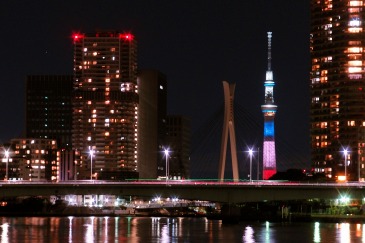 (November 15, from the Sumida River Terrace on Tsukishima toward Chuo-ohashi Bridge)
(November 15, from the Sumida River Terrace on Tsukishima toward Chuo-ohashi Bridge)
And the main feature of the place where this Chuo-ohashi Bridge is located. Isn't that there are three parks where cherry blossoms bloom next to each other?
Tsukuda Park, Ishikawajima Park and Shinkawa Park. In each park, cherry blossoms bloom along the Sumida River in spring, making it a place that adds color to the spring of the Sumida River.
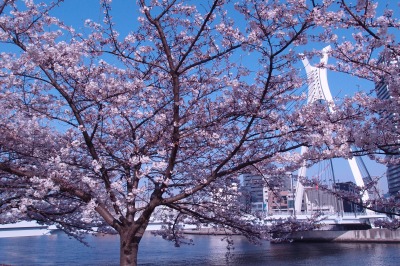 (2015: Ishikawajima Park)
(2015: Ishikawajima Park)
When you walk through the park, you will just put cherry blossoms and Chuo-ohashi Bridge in the square in the photo. There may not be so many bridges surrounded by cherry blossoms.
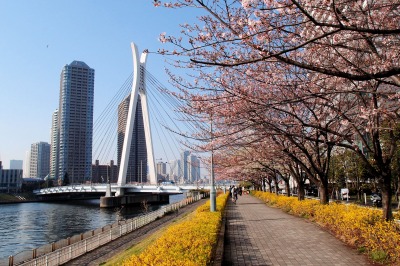 (2015: Shinkawa Park)
(2015: Shinkawa Park)
If you look at it in this way, the spring Chuo-ohashi Bridge looks like a "koto".
The cable is thread, and the white main tower is like a huge koto pillar, "Spring Sea" or "Sakura Sakura" ... You can hear the performance of spring.
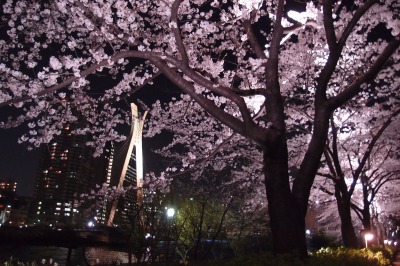 (2015: Tsukuda Park)
(2015: Tsukuda Park)
The cherry blossoms bloom in spring. It seems to take a little longer to visit, but when it gets warmer and the season comes, try surrounded by cherry blossoms blooming around Chuo-ohashi Bridge.
And how about trying to feel the sound of spring?
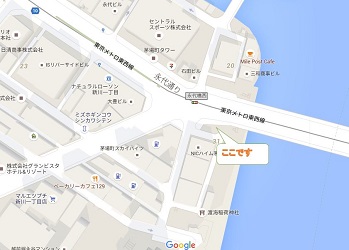 ・
・・ 2/17 Shooting
・ 2/19 shooting
・ 2/19 shooting
・ 2/22 Shooting
・ 2/22 Shooting
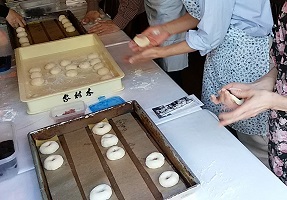
 (Kawazu Sakura on February 14)
(Kawazu Sakura on February 14)

 Well, what does each person look like? You may be better at this kind of thing.
Well, what does each person look like? You may be better at this kind of thing.
 (Example of Shahari Bridge: Onomichi-ohashi Bridge (back) and Shin-Onomichi-ohashi Bridge (front) in Onomichi)
(Example of Shahari Bridge: Onomichi-ohashi Bridge (back) and Shin-Onomichi-ohashi Bridge (front) in Onomichi) (plan view of the bridge girder)
(plan view of the bridge girder) It is a statue holding a sailing ship, the emblem of Paris, on his right arm, but from the top of the bridge, the front side of the statue is not clearly visible, and it is mysterious place of this statue that I do not know what is going on.
It is a statue holding a sailing ship, the emblem of Paris, on his right arm, but from the top of the bridge, the front side of the statue is not clearly visible, and it is mysterious place of this statue that I do not know what is going on. (November 15, from the Sumida River Terrace on Tsukishima toward Chuo-ohashi Bridge)
(November 15, from the Sumida River Terrace on Tsukishima toward Chuo-ohashi Bridge) (2015: Ishikawajima Park)
(2015: Ishikawajima Park) (2015: Shinkawa Park)
(2015: Shinkawa Park) (2015: Tsukuda Park)
(2015: Tsukuda Park)